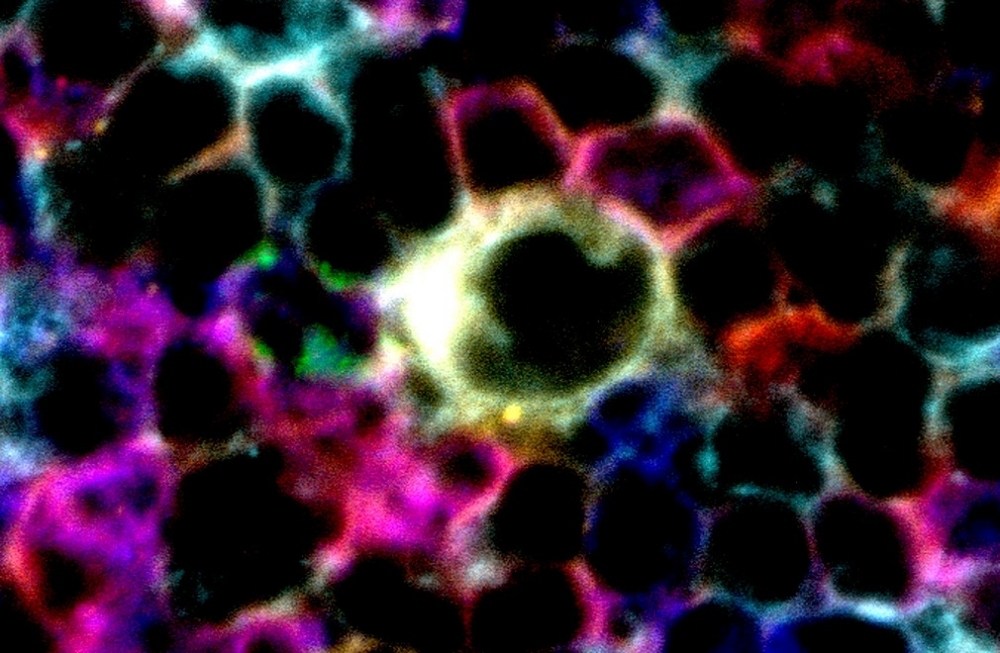

A Brazilian team at FAPESP-supported Center for Research on Inflammatory Diseases identified the strategy used by immune cells to combat the pathogen Mayaro virus, which causes symptoms similar to those of chikungunya fever. These results pave the way for the development of drugs (different cells interacting to create the immune response; image: Peter Lane and Fiona McConnell / Wellcome Collection)
A Brazilian team at FAPESP-supported Center for Research on Inflammatory Diseases identified the strategy used by immune cells to combat the pathogen Mayaro virus, which causes symptoms similar to those of chikungunya fever. These results pave the way for the development of drugs.
A Brazilian team at FAPESP-supported Center for Research on Inflammatory Diseases identified the strategy used by immune cells to combat the pathogen Mayaro virus, which causes symptoms similar to those of chikungunya fever. These results pave the way for the development of drugs.

A Brazilian team at FAPESP-supported Center for Research on Inflammatory Diseases identified the strategy used by immune cells to combat the pathogen Mayaro virus, which causes symptoms similar to those of chikungunya fever. These results pave the way for the development of drugs (different cells interacting to create the immune response; image: Peter Lane and Fiona McConnell / Wellcome Collection)
By Maria Fernanda Ziegler | Agência FAPESP – The mechanism by which defense cells respond to infection by Mayaro virus has been described by a team affiliated with the Center for Research on Inflammatory Diseases (CRID) in an article published in the journal PLOS Pathogens.
According to the authors, by establishing an experimental model of Mayaro fever in adult mice and identifying the processes involved in the immune response, the study provides a basis for the development of drugs against this disease.
CRID is one of the Research, Innovation and Dissemination Centers (RIDCs) funded by FAPESP. It is hosted by the University of São Paulo’s Ribeirão Preto Medical School (FMRP-USP) in São Paulo state, Brazil.
Mayaro fever is a mosquito-borne viral disease similar to chikungunya fever. The symptoms include fever, rash, headache and muscle pain. The most severe cases also involve joint pain (arthralgia) with or without edema. Mayaro virus recently emerged from the Brazilian Amazon forest to circulate in the Southeast Region. Two cases of Mayaro fever have been reported in Niterói (Rio de Janeiro state), and two have been reported in São Carlos (São Paulo state).
“Mayaro fever is highly inflammatory. Its symptoms can last for months. The good news is that the inflammation is triggered by a defense mechanism that has been widely studied and is well understood,” said Dario Simões Zamboni, a researcher with CRID and the last author of the article.
Zamboni is referring to multiprotein intracellular complexes known as inflammasomes. When this cellular machinery is activated, proinflammatory molecules are produced to tell the immune system that it must send more defense cells to the infection site.
Inflammasomes are also involved in autoimmune disorders, neurodegenerative diseases, some kinds of cancer, and other infectious diseases, such as Zika virus disease and chikungunya fever. In regard to Mayaro virus, the group discovered that triggering inflammasomes by activating the protein NLRP3 increased the production of interleukin-1 beta (IL-1β), a proinflammatory cytokine that plays a key role in immune system signaling.
In this study, researchers developed models of cellular infection in macrophages (white blood cells that are part of the first line of defense) and mice. The experiments showed that Mayaro virus triggered expression of proteins NLRP3, ASC and CASP1, the ones responsible for activating the immune system’s inflammatory response or inflammasomes. NLRP3 was particularly important because of its essential role in the production of immune system signaling molecules.
The authors also showed that the virus activated the NLRP3 inflammasome by inducing the production of reactive oxygen species and potassium efflux from cells into the extracellular space.
In experiments with mice engineered to not express NLRP3, the group confirmed the protein’s role in foot pain, swelling and inflammation. “In addition to the experiments in cultured cells and the animal model, we also compared the results with findings for blood serum collected from patients infected by Mayaro virus in the state of Mato Grosso,” Zamboni explained. “The patients were found to have far higher levels of CASP1, IL-1β and interleukin-18 [IL-18] than healthy subjects, evidencing activation of the NLRP3 inflammasome in response to infection by Mayaro virus in humans.”
Emerging virus
According to Luiza Castro-Jorge, a virologist and the first author of the article, Mayaro virus is considered an emerging virus that at any moment may cause major outbreaks in Brazil. “Researchers at the Federal University of Rio de Janeiro [UFRJ] and FMRP-USP have discovered that Mayaro virus is circulating in the Southeast Region,” she said.
The virus is transmitted to humans by the bite of an infected wild mosquito of the genus Haemagogus, which also transmits sylvatic yellow fever.
Although several inflammasomes have been described, the NLRP3 inflammasome is the most studied, which is noted by the researchers in the article. “Drugs are being tested to inhibit the gene for NLRP3 and could, in the future, be used to make the disease less severe in patients,” Zamboni said.
The article “The NLRP3 inflammasome is involved with the pathogenesis of Mayaro virus” (doi: 10.1371/journal.ppat.1007934) by Luiza A. de Castro-Jorge, Renan V. H. de Carvalho, Taline M. Klein, Carlos H. Hiroki, Alexandre H. Lopes, Rafaela M. Guimarães, Marcílio Jorge Fumagalli, Vitor G. Floriano, Mayara R. Agostinho, Renata Dezengrini Slhessarenko, Fernando Silva Ramalho, Thiago M. Cunha, Fernando de Q. Cunha, Benedito A. L. da Fonseca and Dario S. Zamboni can be read at: journals.plos.org/plospathogens/article?id=10.1371/journal.ppat.1007934.
Republish
The Agency FAPESP licenses news via Creative Commons (CC-BY-NC-ND) so that they can be republished free of charge and in a simple way by other digital or printed vehicles. Agência FAPESP must be credited as the source of the content being republished and the name of the reporter (if any) must be attributed. Using the HMTL button below allows compliance with these rules, detailed in Digital Republishing Policy FAPESP.




